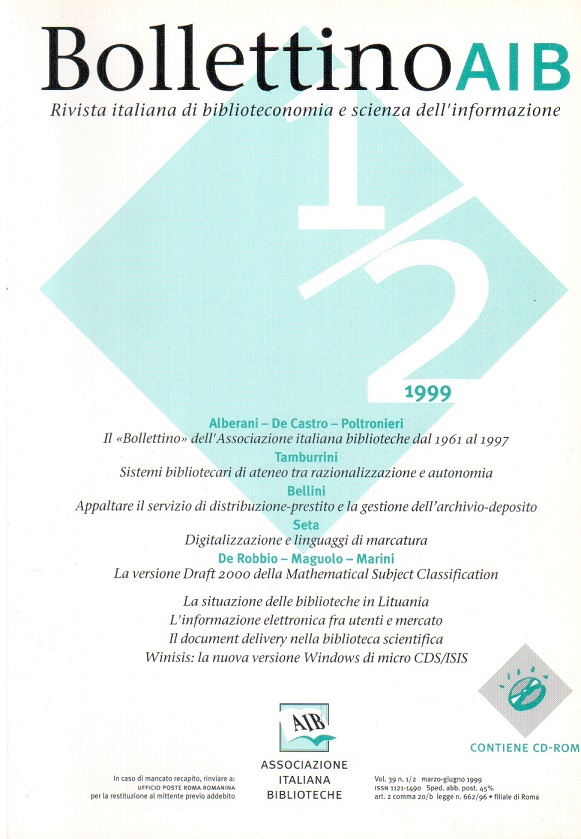The «Bollettino AIB» from 1961 to 1997: an information, education and cooperation tool
Main Article Content
Abstract
A survey of the most relevant items published in the Bulletin of the Italian Library Association over a thirty-seven years period is reported. The study aims to represent the development of professional interests in librarianship and information sciences through its literature.
A brief editorial history of the Bulletin is outlined, including data on its format and layout, frequency, number of issues and pages per year, names of the journal editors, annual and cumulative indexes, monographic issues and supplements. Furthermore, the development of its "sections" is reported and comments are given to explain the changes occurred through the years.
The core of the survey is represented by the analysis of each item published in the Bulletin according to different parameters (publication type, subject category, etc.) with the objective to outline the trend of the contributions published in the given period. All data were manually taken from the single issues and then included in a database to be automatically processed. In the first stage of the analysis, all items were assigned to a publication type according to the Bulletin structure of the year 1992 which included: articles, bibliographies, discussions, documents, editorials, materials, opinions, profiles; also book reviews and notes were considered in the analysis. A brief explanation for each "container" type is given to make the readers understand how the selection was worked out. The analysis was carried out for each single year, within the established period, but data were then grouped into four major periods corresponding to different editorial boards and policies (1961-1970, 1971-1980, 1981-1991, 1992-1997); this permitted to easily compare the results obtained and also to limit the length of the tables containing such data.
The second stage of the survey regarded subject analysis. Each contribution was assigned to a class according to the scheme of the Italian Professional Literature (LPI) section, appearing in the Bulletin since 1975. It contains 20 main classes, each one divided into a number of sub-classes. The results were also grouped into the four large periods, as above, and according to the general classification number, even if the analysis contained also the indication of the sub-class of each item. The analytical data (classes and sub-classes) were reported only for the classes which ranked first. Book reviews and notes were considered separately from the other types of publications and the results of the subject analysis from the two groups were then compared in order to give a general trend of all items included in the Bulletin. This permitted to reflect on the changing interests of Italian librarians and information scientists as appearing through the main journal of their professional association. The following stage of the survey regarded the authors (both personal and corporate) of the contributions published in the Bulletin. The number (one, two, three, more than three) of authors of each item was reported as well as their nationality. Data on the language of the books reviewed were also collected.
The results obtained permit to have a general idea of the association life, interests, discussions and researches carried on and give many hints for reflection on its editorial policy.
Article Details

This work is licensed under a Creative Commons Attribution-ShareAlike 4.0 International License.
